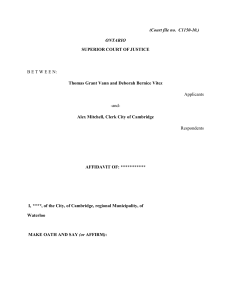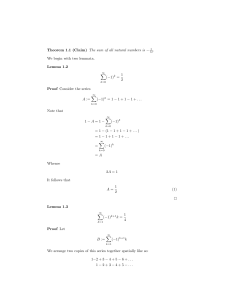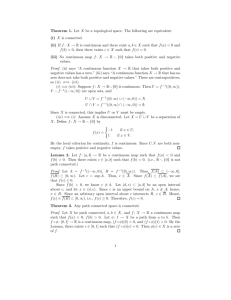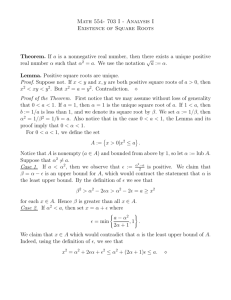Four Proofs of the Ballot Theorem
advertisement
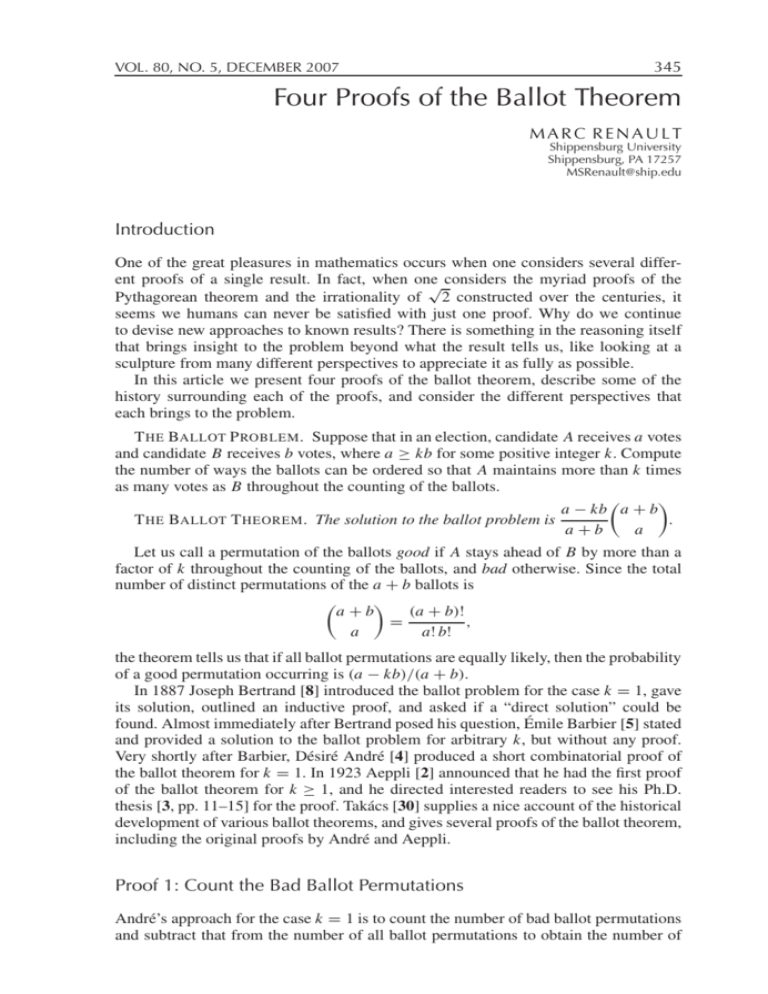
VOL. 80, NO. 5, DECEMBER 2007
345
Four Proofs of the Ballot Theorem
MARC RENAULT
Shippensburg University
Shippensburg, PA 17257
MSRenault@ship.edu
Introduction
One of the great pleasures in mathematics occurs when one considers several different proofs of a single result. In fact, when one
√ considers the myriad proofs of the
Pythagorean theorem and the irrationality of 2 constructed over the centuries, it
seems we humans can never be satisfied with just one proof. Why do we continue
to devise new approaches to known results? There is something in the reasoning itself
that brings insight to the problem beyond what the result tells us, like looking at a
sculpture from many different perspectives to appreciate it as fully as possible.
In this article we present four proofs of the ballot theorem, describe some of the
history surrounding each of the proofs, and consider the different perspectives that
each brings to the problem.
T HE BALLOT P ROBLEM . Suppose that in an election, candidate A receives a votes
and candidate B receives b votes, where a ≥ kb for some positive integer k. Compute
the number of ways the ballots can be ordered so that A maintains more than k times
as many votes as B throughout the counting of the ballots.
a − kb a + b
T HE BALLOT T HEOREM . The solution to the ballot problem is
.
a+b
a
Let us call a permutation of the ballots good if A stays ahead of B by more than a
factor of k throughout the counting of the ballots, and bad otherwise. Since the total
number of distinct permutations of the a + b ballots is
a+b
(a + b)!
,
=
a
a! b!
the theorem tells us that if all ballot permutations are equally likely, then the probability
of a good permutation occurring is (a − kb)/(a + b).
In 1887 Joseph Bertrand [8] introduced the ballot problem for the case k = 1, gave
its solution, outlined an inductive proof, and asked if a “direct solution” could be
found. Almost immediately after Bertrand posed his question, Émile Barbier [5] stated
and provided a solution to the ballot problem for arbitrary k, but without any proof.
Very shortly after Barbier, Désiré André [4] produced a short combinatorial proof of
the ballot theorem for k = 1. In 1923 Aeppli [2] announced that he had the first proof
of the ballot theorem for k ≥ 1, and he directed interested readers to see his Ph.D.
thesis [3, pp. 11–15] for the proof. Takács [30] supplies a nice account of the historical
development of various ballot theorems, and gives several proofs of the ballot theorem,
including the original proofs by André and Aeppli.
Proof 1: Count the Bad Ballot Permutations
André’s approach for the case k = 1 is to count the number of bad ballot permutations
and subtract that from the number of all ballot permutations to obtain the number of
346
MATHEMATICS MAGAZINE
good ballot permutations. Briefly, André supposes that a ballots are marked “A” and
b ballots are marked“B”. He first notes that every ballot permutation starting with B
is bad, and there are a+b−1
of these. Through a reversible procedure, he demonstrates
a
a one-to-one correspondence between the bad ballot permutations starting with
A,
and all permutations consisting of a A’s and b − 1 B’s. Again, these number a+b−1
.
a
a+b−1
He concludes that the number of bad ballot permutations is 2 a , and the ballot
a−b a+b
− 2 a+b−1
= a+b a .
theorem then follows by simplifying a+b
a
a
The ballot problem and its solution caught the imagination of mathematicians, and
many variations of André’s proof have appeared throughout the years. For instance,
Percy MacMahon [18] applied his deep theory of partitions to the problem. The most
famous and elegant of these variations is the “reflection method” (often misattributed
to André) in which ballot permutations are represented as lattice paths and portions
of the bad paths are reflected across a line. This method was developed in the pair of
papers [1] and [19] in 1923. Interestingly, the reflection method fails to generalize in
a way that solves the ballot problem for k > 1. See [23] for more detail on André’s
original proof, the reflection method, and extending André’s original proof to the case
k ≥ 1.
In 2003 Goulden and Serrano [14] provided a clever proof of the ballot theorem
(for k ≥ 1) using André’s “count the bad ballot permutations” approach [14], and we
present a variation of that proof here. Their proof rotates a portion of a lattice path
instead of reflecting it.
Proof 1. We can think of a ballot permutation as a lattice path starting at (0, 0)
where votes for A are expressed as upsteps (1, 1) and votes for B are expressed as
downsteps (1, −k). We seek the number of such paths with a upsteps and b downsteps
where no step ends on or below the x-axis. Paths that remain above the x-axis (after
the origin) are good, while those with steps that end on or below the x-axis are bad. A
downstep that starts above the x-axis and ends on or below it is called a bad step.
Figure 1 Example with k = 3. XY ∈ B1 and X̃Y ∈ B3 .
For 0 ≤ i ≤ k, let Bi denote the set of bad paths whose first bad step ends i units
below the x-axis. Clearly these k + 1 sets are disjoint and their union is the set of all
bad paths. Notice
that the paths in Bk are exactly those paths that start with a downstep,
and so |Bk | = a+b−1
. We now show that for any i = k we actually have |Bi | = |Bk |.
a
Let P be a path in Bi (i = k), and identify the first step of P that ends i units
below the x-axis. Let X be the initial segment of P that ends with that step and write
P = X Y . Let X̃ denote the path that results from rotating X by 180◦ , exchanging its
endpoints; see Figure 1. Since X ends with a downstep, X̃ starts with a downstep, and
consequently X̃ Y ∈ Bk .
VOL. 80, NO. 5, DECEMBER 2007
347
The same process converts a path in Bk into a path in Bi (i = k). If P ∈ Bk , then
identify the first step that ends i units below the x-axis. Let X denote the initial segment
of P that ends with that step and write P = X Y . Since X necessarily ends with an
upstep, we have X̃Y ∈ Bi .
Thus each of the k + 1 sets Bi have cardinality a+b−1
, and the number of good
a
paths is
a+b
a+b−1
a − kb a + b
− (k + 1)
=
.
a
a
a+b
a
Of particular interest in this proof is the fact that the sets Bi of bad ballot permutations all have the same cardinality, regardless of i. We say that these sets uniformly
partition the set of bad paths. In Proof 4 we will see another instance of a uniform
partition.
As often happens in mathematics, it appears that the above 2003 proof is essentially
a rediscovery of the 1923 proof by Aeppli. Aeppli’s proof of the ballot theorem appeared in his dissertation [3], and was not widely available until Takács [30] provided
a “somewhat modified version” of the proof in 1997. In his proof, Aeppli uses no geometric reasoning, and instead of counting the number of good ballot permutations he
computes the probability that a ballot permutation is good (provided, of course, that
all ballot permutations are equally likely). He partitions the bad ballot permutations
in exactly the same manner as the preceding proof does; moreover, to show a oneto-one correspondence he reverses an initial portion of a ballot permutation, which is
geometrically equivalent to rotating an initial portion of a lattice path.
Proof 2: Induction
In 1887 Barbier stated the ballot theorem for k ≥ 1 without proof. If he had a proof,
one supposes it followed the inductive proof that Bertrand sketched for the case k = 1.
An inductive proof is not difficult to construct, and no record seems to exist for the
“first” such proof of the ballot theorem. The following proof is similar to that found in
Takács [30].
Proof 2. Let Nk (a, b) denote the number of ways the a + b ballots (a ≥ kb) can
be ordered so that candidate A maintains more than k times as many votes as B
throughout the counting of the ballots. The conditions Nk (a, 0) = 1 for all a > 0 and
Nk (kb, b) = 0 for all b > 0, are easily verified by considering
the statement of the
a+b
ballot problem, and they both satisfy Nk (a, b) = a−kb
.
a
a+b
For b > 0 and a > kb, we see that Nk (a, b) = Nk (a, b − 1) + Nk (a − 1, b)
by considering
last vote
By
this quantity is
thea−1−kb
a+b−1in a ballot permutation.
induction,
a−k(b−1) a+b−1
a−kb a+b
+
which
simplifies
to
as
needed.
a+b−1
a+b−1
a+b
a
a−1
a
Proof 3: The Cycle Lemma
In the ballot
we are given an expression where the total number of ballot per theorem
mutations a+b
is
multiplied
by the fraction (a − kb)/(a + b). Dvoretzky and Motzkin
a
[12] solve the ballot problem by introducing the cycle lemma which makes evident the
reason for the fraction. The cycle lemma provides a surprising result: for any ballot
sequence of a votes for A and b votes for B, exactly a − kb of the a + b cyclic permutations of the sequence are good. Consequently, a fraction of (a − kb)/(a + b) of
all ballot permutations are good.
348
MATHEMATICS MAGAZINE
Dershowitz and Zaks [11] give two elegant proofs of the cycle lemma. Their first
proof is a generalization (and simplification) of the proofs in [7], [25], and [26]; their
second proof follows [15], [22], and [32]. In the following proof of the ballot theorem,
we include what is essentially their first proof of the cycle lemma.
Proof 3. We can express a ballot permutation as a sequence of a + b terms where
each term is either 1 or −k; votes for A correspond to the 1’s and votes for B correspond to the −k’s. A sequence is called good if every partial sum is positive, and bad
otherwise. Observe that the sum of a sequence is a − kb ≥ 0.
Let C be any circular arrangement of a 1’s and b −k’s. We now prove the cycle
lemma: of the a + b terms in C, exactly a − kb start good sequences when C is read
once around clockwise.
By the pigeonhole principle there must exist a sequence X = 1, 1, . . . , 1, −k in C
with k consecutive 1’s. No term of X can start a good sequence, for when we get to
the −k we would have a partial sum less than or equal to zero.
Figure 2
Example of C and C with k = 3.
Let C be the circular arrangement created from C by removing X . Since the sequence X has sum 0, it has no “net effect” on good sequences. Thus, a term of C starts a
good sequence if and only if the corresponding term in C starts a good sequence. Consequently, C and C have exactly the same number of terms that start good sequences.
Continuing in this manner, one removes sequences of the form 1, 1, 1, . . . , 1, −k until
a circular arrangement consisting only of 1’s remains. At this stage, there are a − kb
1’s, and every term starts a good sequence. Hence there are exactly a − kb good sequences in C, and the cycle lemma is proved.
If there is periodicity in C then not all a − kb good sequences will be distinct.
However, we can conclude that the ratio of good sequences to all sequences is a − kb
to a + b. Therefore, the number of good sequences is
a − kb a + b
.
a+b
a
Dvoretzky and Motzkin [12] state and prove the cycle lemma as a means of solving
the ballot problem, but Dershowitz and Zaks [11] point out that this is a “frequently
rediscovered combinatorial lemma” and they provide two other applications of the
lemma. They write,
The Cycle Lemma is the combinatorial analogue of the Lagrange inversion formula; see Raney [22], Cori [10], and Gessel [13]. Other proofs of varying degree of generality may be found in Dvoretzky and Motzkin [12] (discussed in
Grossman [15]), Motzkin [21] (two proofs), Hall [16], Raney [22], Yaglom and
Yaglom [32], Takács [29], Silberger [25], Bergman [7] (three proofs), Sands [24]
and Singmaster [26]. (The first paper [12] is not credited by the other authors,
VOL. 80, NO. 5, DECEMBER 2007
349
but is referenced in Barton and Mallows [6] and Mohanty [20].) Dvoretzky and
Motzkin, Motzkin, and Yaglom and Yaglom give the lemma in its general form;
the other papers prove only the case k = 1 or a − kb = 1. Generalizations of the
Cycle Lemma to non-integer k and sequences of reals may be found in Dvoretzky
and Motzkin [12] and Spitzer [27], respectively.
(Reference numbers and notation in the above quote have been modified for consistency with this paper.)
Proof 4: A Uniform Partition
Consider the 2n
possible lattice paths starting from the origin and consisting of n
n
upsteps (1, 1) and n downsteps (1, −1). It turns out, surprisingly, that the number of
these paths with i upsteps above the x-axis (0 ≤ i ≤ n) is the same, regardless of
the value of i. Consequently, the number of paths with all n upsteps above the x-axis
must be 2n
/(n + 1). This fact is often called the Chung-Feller theorem [9, Thm. 2A];
n
however, it was actually given in 1909 by MacMahon [18, p. 167, §20] in the process
of solving the ballot problem (for k = 1) via the theory of partitions.
In the following
proof we apply a similar approach by creating a set with
(a − kb) a+b
elements,
and partitioning this set into a + b subsets of equal size (that
a
is, we uniformly partition into a + b subsets). One of the subsets corresponds to the
set of good ballot permutations, and from this we can conclude the ballot theorem. It
appears that the following proof is the first to prove the ballot theorem by means of a
uniform partition. It is based on and extends the proofs found in [31].
Proof 4. Consider lattice paths starting from the origin and consisting of a upsteps
(1, 1) and b downsteps (1, −k), and assume the strict inequality a > kb. Let A =
A(a, b, k) be the set of all such paths. Given path P ∈ A we let L(P) denote the
set of x-values of the a − kb “rightmost lowest” vertices of P; see Figure 3. More
precisely, given path P ∈ A, let y0 denote the least y-value of all the vertices of P,
and let r (t) denote the x-value of the rightmost vertex of P along the line y = t; then
L(P) = {r (t) | t ∈ Z, y0 ≤ t ≤ y0 + (a − kb) − 1} .
Let = {(P, j) | P ∈ A, j ∈ L(P)} and note that || = (a − kb) |A|. Let i =
{(P, i) ∈ | i ∈ L(P)}, defined for 0 ≤ i ≤ a + b − 1. The sets i partition into
a + b disjoint subsets.
Claim 1: There is a one-to-one correspondence between 0 and the set of good
paths. If P ∈ A is good, then (0, 0) is the lowest vertex in P and it is the only vertex
on the x-axis, so (P, 0) ∈ 0 . Conversely, if (P, 0) is in 0 , then no vertex of P can
lie on the x-axis to the right of the origin, and so P is good.
Claim 2: The sets i uniformly partition . We show this by providing a one-to-one
correspondence between i and 0 . If (P, i) ∈ i , then write P = X Y where X is the
initial path of P consisting of the first i steps, and Y consists of the remaining steps.
Since i ∈ L(P), we can observe that Y stays above the height of its initial vertex,
and X never descends a − kb or more units below the height of its terminal vertex.
Consequently the path Y X is good and (Y X, 0) ∈ 0 . Conversely, if (Q, 0) ∈ 0 ,
then write Q = Y X where X consists of the final i steps of Q. The same qualities of
X and Y hold as noted above, and the pair (X Y, i) ∈ i .
The two claims above imply that the number of good paths in A is
||
(a − kb) |A|
a − kb a + b
|0 | =
=
=
.
a+b
a+b
a+b
a
350
MATHEMATICS MAGAZINE
Figure 3 Example with k = 2, a = 6, b = 2. For each path P ∈ A, the path P and the set
L(P ) are shown. Observe that among all the sets L(P ), each number from 0 to 7 occurs
exactly 7 times.
Suppose we let Ai denote the set of paths for which i is among the x-values of
the a − kb rightmost vertices, i.e., Ai = {P ∈ A | i ∈ L(P)}. When a − kb = 1, the
sets A0 , A1 , . . . , Aa+b−1 are disjoint and all have the same cardinality. In other words,
partitioning A according to the x-value of a path’s rightmost lowest vertex creates a
uniform partition of A.
Curiously, when we allow a − kb ≥ 1, the sets Ai continue to have the same cardinality. However, they are no longer disjoint. To the contrary, each path in A will be a
member of precisely a − kb of these sets.
The Weak Ballot Problem, Catalan Numbers
The ballot problem is often stated in a “weak” version: suppose that candidate A receives m votes and candidate B receives n votes, where m ≥ kn for some positive
integer k, and compute the number of ways the ballots can be ordered so that A always
has at least k times as many votes as B throughout the counting of the ballots.
VOL. 80, NO. 5, DECEMBER 2007
351
Any ballot permutation in which A maintains at least k times the number of votes
for B can be converted into one in which A maintains more than k times the number
of votes for B by simply appending a vote for A to the beginning of the permutation.
Clearly this process is reversible, and hence the solution to the weak version is the
same as the “strict” version when A receives m + 1 votes and B receives n votes:
(m + 1) − kn (m + 1) + n
m + 1 − kn m + n
=
.
(m + 1) + n
m+1
m+1
m
Putting k = 1 and m = n produces the well-known Catalan numbers
2n
1
.
Cn =
n+1 n
Requiring only that m = kn produces the generalized Catalan numbers, also called
the k-Catalan numbers
(k + 1)n
1
k
.
Cn =
kn + 1
n
The interested reader should see [28, pp. 219–229] and Stanley’s website http://
www-math.mit.edu/~rstan/ec/ for an extensive list of combinatorial interpretations of
the Catalan numbers. Furthermore, see [17] for several interpretations of the generalized Catalan numbers.
Acknowledgments. I would like to extend sincere thanks to the two referees who offered many valuable suggestions.
REFERENCES
1. J. Aebly, Démonstration du problème du scrutin par des considérations géométriques, L’enseignement
mathématique 23 (1923) 185–186.
2. A. Aeppli, A propos de l’interprétation géométrique du problème du scrutin, L’enseignement mathématique
23 (1923) 328–329.
3. A. Aeppli, Zur Theorie verketteter Wahrscheinlichkeitem, Markoffsche Ketten höherer Ordnung, Ph.D. Thesis, Eidgenössische Technische Hochschule, Zürich, 1924.
4. D. André, Solution directe du problème résolu par M. Bertrand, Comptes Rendus de l’Académie des Sciences,
Paris 105 (1887) 436–437.
5. É. Barbier, Généralisation du problème résolu par M. J. Bertrand, Comptes Rendus de l’Académie des Sciences, Paris 105 (1887) p. 407.
6. D.E. Barton and C.L. Mallows, Some aspects of the random sequence, Ann. Math. Stat. 36 (1965) 236–260.
7. G.M. Bergman, Terms and cyclic permutations, Algebra Universalis 8 (1978) 129–130.
8. J. Bertrand, Solution d’un problème, Comptes Rendus de l’Académie des Sciences, Paris 105 (1887) p. 369.
9. K.L. Chung and W. Feller, On fluctuations in coin tossing, Proc. Natl. Acad. Sci. USA 35 (1949) 605–608.
10. R. Cori, in: Combinatorics on Words (M. Lothaire, ed.), Encyclopedia of Mathematics and Its Applications,
vol. 17, Addison-Wesley, Reading, Massachusetts, 1983.
11. N. Dershowitz and S. Zaks, The cycle lemma and some applications, Europ. J. Combinatorics 11 (1990)
35–40.
12. A. Dvoretzky and Th. Motzkin, A problem of arrangements, Duke Math. J. 14 (1947) 305–313.
13. I.M. Gessel, A combinatorial proof of the multivariate Lagrange inversion formula, J. Combin. Theory Ser.
A 45 (1987) 178–195.
14. I.P. Goulden and L.G. Serrano, Maintaining the spirit of the reflection principle when the boundary line has
arbitrary integer slope, J. Comb. Theory, Ser. A 104 (2003) 317–326.
15. H.D. Grossman, Fun with lattice points—21, Scripta math. 16 (1950) 120–124.
16. P. Hall, Some word problems, J. London Math. Soc. 33 (1958) 482–496.
17. P. Hilton and J. Pedersen, Catalan numbers, their generalizations, and their uses, Math. Intell. 13 (1991)
64–75.
18. P.A. MacMahon, Memoir on the theory of the partitions of numbers. part iv: on the probability that the
successful candidate at an election by ballot may never at any time have fewer votes than the one who is
352
19.
20.
21.
22.
23.
24.
25.
26.
27.
28.
29.
30.
31.
32.
MATHEMATICS MAGAZINE
unsuccessful; on a generalization of this question; and on its connexion with other questions of partition,
permutation, and combination, Philosophical Transactions of the Royal Society of London, Series A 209
(1909) 153–175. Also Collected Papers Vol. 1 (G.E. Andrews, ed.), MIT Press, Cambridge, Mass 1978,
1292–1314.
D. Mirimanoff, A propos de l’interprétation géométrique du problème du scrutin, L’enseignement
mathématique 23 (1923) 187–189.
S.G. Mohanty, Lattice Path Counting and Applications, Academic Press, New York, 1979.
Th. Motzkin, Relations between hypersurface cross ratios and a combinatorial formula for partitions of a
polygon, for permanent preponderance, and for non-associative products, Bull. Am. Math. Soc. 54 (1948)
352–360.
G.M. Raney, Functional composition patterns and power series reversion, Trans. Am. Math. Soc. 94 (1960)
441–451.
M.S. Renault, Lost (and found) in translation: André’s actual method and its application to the generalized
ballot problem, Amer. Math. Monthly to appear. See webspace.ship.edu/msrenault/ballotproblem/.
A.D. Sands, On generalized Catalan numbers, Discr. Math. 21(2) (1978) 219–221.
D.M. Silberger, Occurrences of the integer (2n − 2)!/n! (n − 1)!, Roczniki Polskiego Towarzystwa Math. I
13 (1969) 91–96.
D. Singmaster, An elementary evaluation of the Catalan numbers, Am. Math. Monthly 85 (1978) 366–368.
F. Spitzer, A combinatorial lemma and its application to probability theory, Trans. Am. Math. Soc. 82 (1956)
323–339.
R.P. Stanley, Enumerative Combinatorics, Vol. 2, Cambridge University Press, Cambridge, UK, 1999.
L. Takács, Combinatorial Methods in the Theory of Stochastic Processes, John Wiley, New York, 1967.
L. Takács, On the ballot theorems, Advances in Combinatorial Methods and Applications to Probability and
Statistics, Birkhäuser, 1997.
W. Woan, Uniform partitions of lattice paths and Chung-Feller generalizations, Amer. Math. Monthly 108
(2001) 556–559.
A.M Yaglom and I.M. Yaglom, Challenging Mathematical Problems with Elementary Solutions, vol 1: Combinatorial Analysis and Probability Theory, Holden Day, San Francisco, 1964.
To appear in The College Mathematics Journal January 2008
Articles
Christiaan Huygens and the Problem of the Hanging Chain, by John Bukowski
Hermit Points on a Box, by Richard Hess, Charles Grinstead, Marshall Grinstead,
and Deborah Bergstrand
The Right Right Triangle on the Sphere, by William Dickinson and Mohammad Salmassi
Summing Up the Euler φ Function, by Paul Loomis, Michael Plytage, and John Polhill
The Depletion Ratio, by C. W. Groetsch
Classroom Capsules
Pairs of Equal Surface Functions, by Daniel Cass and Gerald Wildenberg
A Tricky Linear Algebra Example, by David Sprows
A Quick Change of Base Algorithm for Fractions, by Juan B. Gil and Michael D. Weiner
A Waiting-Time Surprise, by Richard Parris
The Pearson and Cauchy-Schwarz Inequalities, by David Rose
Columns
Fallacies, Flaws, and Flimflam, Ed Barbeau
Problems and Solutions, Jim Bruening and Shing So
Media Highlights, Warren Page
Pólya Award Winners
